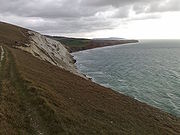
Compton Bay
Encyclopedia

Bay
A bay is an area of water mostly surrounded by land. Bays generally have calmer waters than the surrounding sea, due to the surrounding land blocking some waves and often reducing winds. Bays also exist as an inlet in a lake or pond. A large bay may be called a gulf, a sea, a sound, or a bight...
located on the southwest section of the Isle of Wight
Isle of Wight
The Isle of Wight is a county and the largest island of England, located in the English Channel, on average about 2–4 miles off the south coast of the county of Hampshire, separated from the mainland by a strait called the Solent...
, England
England
England is a country that is part of the United Kingdom. It shares land borders with Scotland to the north and Wales to the west; the Irish Sea is to the north west, the Celtic Sea to the south west, with the North Sea to the east and the English Channel to the south separating it from continental...
. The northern edge of the bay is defined by a distinctive white chalk cliff
Cliff
In geography and geology, a cliff is a significant vertical, or near vertical, rock exposure. Cliffs are formed as erosion landforms due to the processes of erosion and weathering that produce them. Cliffs are common on coasts, in mountainous areas, escarpments and along rivers. Cliffs are usually...
called Freshwater Cliff, named after Freshwater Bay
Freshwater, Isle of Wight
Freshwater is a large village and civil parish at the western end of the Isle of Wight, England. Freshwater Bay is a small cove on the south coast of the Island which also gives its name to the nearby part of Freshwater....
which is located next to them and forms a small but piercing bay into them. The eastern edge of the bay is formed from soft red and orange cretaceous
Cretaceous
The Cretaceous , derived from the Latin "creta" , usually abbreviated K for its German translation Kreide , is a geologic period and system from circa to million years ago. In the geologic timescale, the Cretaceous follows the Jurassic period and is followed by the Paleogene period of the...
rocks that are rapidly eroding.
The bay is popular with wave and kite surfers
Kitesurfing
Kitesurfing or Kiteboarding is an adventure surface water sport that has been described as combining wakeboarding, windsurfing, surfing, paragliding, and gymnastics into one extreme sport. Kitesurfing harnesses the power of the wind to propel a rider across the water on a small surfboard or a...
due to the reliable and consistent waves that form when the prevailing south-westerly wind is blowing onshore. The beach is gently shelving and consists mostly of sand. The public facilities at the car park are owned by the National Trust
National Trust for Places of Historic Interest or Natural Beauty
The National Trust for Places of Historic Interest or Natural Beauty, usually known as the National Trust, is a conservation organisation in England, Wales and Northern Ireland...
.
There are dinosaur
Dinosaur
Dinosaurs are a diverse group of animals of the clade and superorder Dinosauria. They were the dominant terrestrial vertebrates for over 160 million years, from the late Triassic period until the end of the Cretaceous , when the Cretaceous–Paleogene extinction event led to the extinction of...
footprint
Fossil trackway
A fossil trackway is a type of trace fossil, a trackway made by an organism. Many fossil trackways were made by dinosaurs, early tetrapods, and other quadrupeds and bipeds on land...
s visible in Compton Bay when the tide
Tide
Tides are the rise and fall of sea levels caused by the combined effects of the gravitational forces exerted by the moon and the sun and the rotation of the Earth....
is low this is one of the best areas to see the Dinosaurs of the Isle of Wight
Dinosaurs of the Isle of Wight
The Isle of Wight is one of the richest dinosaur localities in Europe, with over 20 species of dinosaur having been recognised from the early Cretaceous Period , some of which were first identified on the island, as well as the contemporary non-dinosaurian species of crocodile, turtle and...
. At high tide the sea covers the beach almost completely.
The Isle of Wight Coastal Path
Isle of Wight Coastal Path
.There are a couple of cafes on the cliff path which I believe are open in the summer months. The only public convenience on the cliff path now appears to be closed permanently ....
runs along the cliff edge for the entire extent of the bay.
Surfing
Compton Bay is the Isle of wight's most famous surf spot, With a choice of a rocky reefReef
In nautical terminology, a reef is a rock, sandbar, or other feature lying beneath the surface of the water ....
break or a slightly tamer but heavier sandbar break to choose from Compton Bay is the Island surfers spot of choice, Compton Bay has proved to be a valuable playground over the years to some of the Island's best surfers such as Johnny Fryer, Joe Trueman, Dave Gray, Ray Hutchings, Alan Reed, Dylan Gray and Zoe Sheath

